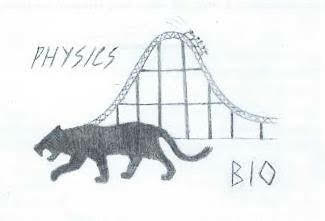Get on the Bus – It’s Time for the Science Field Trips!

Art credits to Alicia Jen!
April 20, 2016
It’s the middle of May, and after weeks of studying and testing, you’re finally finished with the grueling AP exams. The first thing on your mind might be kicking back and relaxing, maybe going out more often or spending more time with your friends. On the other hand, your teachers are still eager to, well, teach; after all, there’s still more than a month until summer. Is there any hope of compromise, or will the conflict escalate into all-out war?
Some classes have a way to satisfy both sides, a method that’s been lost since the days of the William Annin D.C. visit: a field trip! While the Magic School Bus unfortunately doesn’t come to Ridge, the Physics and AP Biology teachers have still worked to organize annual excursions that have the fun of a summer day trip, yet compel students to apply the year’s learning to the real world.
One entertaining element that precedes both trips is the designing of the T-shirts. The brightly-colored shirts are meant to make it easier for teachers to identify people from Ridge, but to make this safety measure a bit more interesting, students are allowed to submit designs for the shirts. Whether punny, artistic, or a bit of both, the winning designs get to be proudly displayed by dozens or hundreds of the designer’s classmates and are often a talking point for the whole grade.
Besides their shirts, what else should students bring? While a school backpack with twenty pounds of binders isn’t necessary, it’s a good idea to bring a small bag, such as a drawstring bag, to carry some light supplies. Bring some water and snacks, and some money for lunch or refreshments. Since it will probably be hot and sunny, make sure to put on sunscreen, and bring a hat and sunglasses if you want. On the other hand, the weather might not be so nice. Likely remembering last year’s chilly, rainy annual physics trip, Luca Jobbágy ’16 suggests, “Dress in layers.” Definitely check the weather before you leave home! Finally, don’t forget writing utensils, as well as the notes and worksheets assigned by your teachers. It is a school trip, after all.
What will each class be doing, exactly? Within the physics department, every physics class – virtually all juniors and senior AP Physics C students – will spend a day in early June at Six Flags Great Adventure, gleefully observing mechanics in action while having a blast with the world-renowned attractions. The park itself provides physics worksheets for rides of the student’s choice, with calculations like finding the work necessary to bring a roller coaster car up a hill, or the centripetal force acting on a rotating merry-go-round.
It’s an engaging change from the classroom norm; Shreyes Manivel ’17 believes that “The great thing about having the trip to Great Adventure is that students can truly visualize, ergo understand, the things they learn in the classroom through real-life applications.” After all, what’s more exciting: puzzling over a static image of a sliding block, or seeing – even experiencing – the acceleration as a car speeds down Kingda Ka? Even with the assignment, Jacob Clott ’17 states that “I’m really excited to get to visit Six Flags and hang out with friends. It’s good to relax and get a day off from school.”
The biology trip might be tamer in terms of rides, but definitely not in wildlife. In May, AP Biology students have a chance to go to the Bronx Zoo in New York City as part of the class’s animal behavior project. Before the trip, students will have picked an animal and researched its behavior in the wild. Then, at the zoo, they’ll spend the morning recording observations of their chosen animal in its zoo exhibit.
“Having to do any kind of work isn’t fun, but at least you’re with your friends and your work consists of watching cute animals,” Lauren Sang ’16 comments cheerfully. For the afternoon, though, students can freely wander the award-winning zoo; don’t miss the gorillas and their babies, or the sea lion feedings!
Back at home, the biology students write a paper comparing and contrasting their animals’ behavior in the wild and in captivity and making recommendations to improve their given exhibit. In this way, the project mingles the classroom topics of ecology and behavior with the pressing real-world issues of conservation and animal welfare. Manivel states, “I think the students attending will get a wonderful experience to see for themselves how animals behave. More importantly, this raises the topic of animal behavior in captive environments; I hope to further understand if the environment my specific animal, the Amur Tiger, lives in drastically changes its natural behavior.” Hopefully, students come out of the AP Bio class with both great exam scores and a more conscientious mind.
A lot of the science curriculum depends on doing problems on paper, and even labs are usually limited to artificial models in the classroom. The two field trips bring the concepts outside of the textbook and into the real world in an enjoyable and educational way, helping to restore the childhood wonder in science we all had. After a busy junior or senior year, the trips will certainly evoke memories of more carefree days – and create exciting new ones.

Shreyes M. • Dec 20, 2016 at 11:13 am
The field trips were really cool!
Brian Wen • Dec 20, 2016 at 11:12 am
This is really cool.